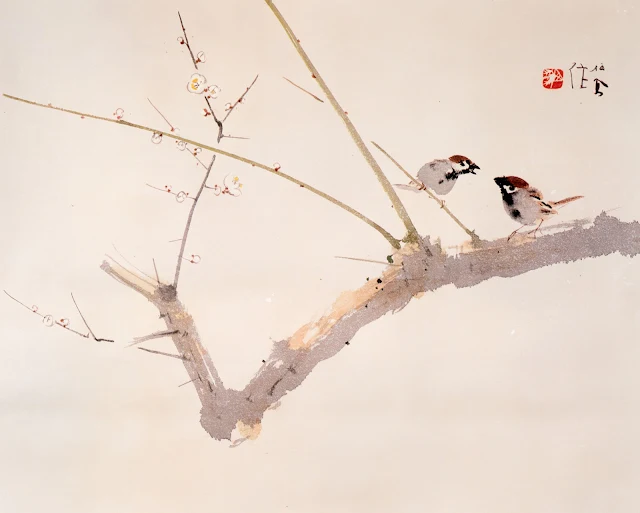
Bird-and-flower painting, or huaniaohua in Chinese, is a genre of Chinese painting that depicts various natural subjects, such as flowers, birds, fish, and insects.
It has a long history and tradition in China and is considered one of the treasures of Chinese culture.
In this blog post, I will introduce some of the features, styles, and artists of this genre, as well as its cultural significance and symbolism.
{tocify} $title={Table of Contents}
Origins and Development
Bird-and-flower painting originated in the Tang dynasty (618-907), where it gained popularity among the imperial court and the literati.
It matured by the end of the Tang period and during the Five Dynasties and Ten Kingdoms period (907-960) and reached its peak during the Song dynasty (960-1279).
Most bird-and-flower paintings belong to the scholar-artist style of Chinese painting, which emphasizes personal expression, brushwork, and poetic mood.
There were two main schools of bird-and-flower painting in the Song dynasty: the realistic school and the freehand school.
The realistic school, led by Huang Quan (c. 900-965), used meticulous outlines and bright colors to depict the natural forms and details of the subjects.
The freehand school, led by Xu Xi (937-975), used loose strokes and ink washes to create an impressionistic and expressive effect.
Both schools influenced later generations of painters in China and other East Asian countries.
Cultural Significance and Symbolism
Bird-and-flower painting was not simply a way of imitating nature, but also a way of conveying the personality and ideas of the artist.
In Chinese culture, different types of birds and flowers have their own symbolic meanings, such as auspiciousness, scholarly virtues, human principles, or moral lessons.
- Plum Blossom: Represents resilience and purity, as it blooms in the cold winter.
- Orchid: Symbolizes elegance and integrity, as it grows in secluded places.
- Bamboo: Signifies loyalty and strength, as it bends but does not break.
- Chrysanthemum: Denotes longevity and nobility, as it flourishes in the autumn.
- Peony: Indicates wealth and honor, as it is known as the king of flowers.
- Magpie: Signifies happiness and good fortune, as it is a messenger of joy.
- Crane: Implies longevity and immortality, as it is a companion of immortals.
- Phoenix: Represents harmony and prosperity, as it is considered the king of birds.
And so on, with each symbol carrying its unique meaning and significance in various cultural contexts.
Scholar-artists also integrated calligraphy and poetry into their bird-and-flower paintings, giving them a deeper spiritual meaning.
They used their paintings as a medium to express their emotions, thoughts, aspirations, or criticisms of society.
They also used them as a way of cultivating their moral character, aesthetic taste, and spiritual enlightenment.
Scholar artists, in particular, developed a freehand style of painting as a means to express their emotions and aspirations.
They also considered Chinese calligraphy and poetry as being an integral component of their huaniaohua paintings, by giving them a deeper spiritual meaning.
The huaniaohua paintings were often used as gifts, decorations, or collections by the scholar-artists themselves or their friends.
Famous Artists and Works
Some of the most famous artists and works of bird-and-flower painting are:
- Huang Quan: Court Paintings of Birds-and-Flowers (10th century), a series of paintings that depict various birds and flowers in a realistic style.
- Xu Xi: Ink Bamboo (10th century), a painting that shows bamboo branches in a freehand style.
- Emperor Huizong: Auspicious Cranes (12th century), a painting that depicts cranes flying over the palace in a symbolic gesture of peace.
- Lin Liang: Birds on a Snowy Day (15th century), a painting that portrays birds perching on snowy branches in a lively manner.
- Shen Zhou: Poet on a Mountaintop (15th century), a painting that combines landscape, bird-and-flower, figure, calligraphy, and poetry elements in one composition.
- Qi Baishi: Flowers with Insects (20th century), a painting that illustrates flowers with insects in a simple but vivid style.
Influence and Legacy
The huaniaohua genre had a lasting impact on Chinese culture and art, as well as on other East Asian cultures, such as Korea and Japan.
It also had an influence on Iranian painting in the golomorgh genre of illustration for book covers and illuminated manuscripts.
The huaniaohua genre is still practiced today by many contemporary artists who continue to explore its aesthetic possibilities and cultural meanings.
The huaniaohua paintings are also appreciated by many people around the world who admire their beauty and symbolism.
Conclusion
Bird-and-flower painting is a Chinese painting genre that reflects nature's beauty and meaning.
It has a long history and tradition in China and is considered one of the treasures of Chinese culture.
It showcases the skills, styles, and personalities of different artists and their cultural values and symbolism.
It is also a way of expressing emotions, thoughts, aspirations, or criticisms through art.
This genre deserves appreciation and admiration for its artistic achievements and cultural significance.

Post a Comment